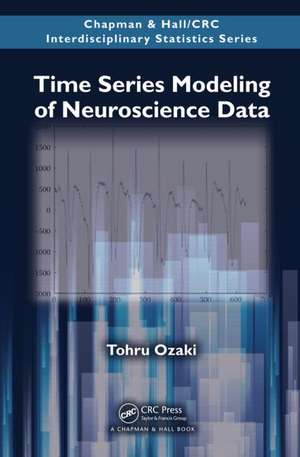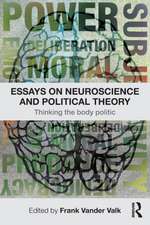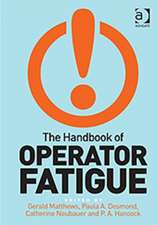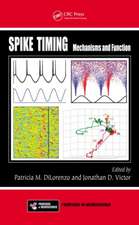Time Series Modeling of Neuroscience Data: Chapman & Hall/CRC Interdisciplinary Statistics
Autor Tohru Ozakien Limba Engleză Hardback – 26 ian 2012
Time Series Modeling of Neuroscience Data shows how to efficiently analyze neuroscience data by the Wiener-Kalman-Akaike approach, in which dynamic models of all kinds, such as linear/nonlinear differential equation models and time series models, are used for whitening the temporally dependent time series in the framework of linear/nonlinear state space models. Using as little mathematics as possible, this book explores some of its basic concepts and their derivatives as useful tools for time series analysis. Unique features include:
- A statistical identification method of highly nonlinear dynamical systems such as the Hodgkin-Huxley model, Lorenz chaos model, Zetterberg Model, and more
- Methods and applications for Dynamic Causality Analysis developed by Wiener, Granger, and Akaike
- A state space modeling method for dynamicization of solutions for the Inverse Problems
- A heteroscedastic state space modeling method for dynamic non-stationary signal decomposition for applications to signal detection problems in EEG data analysis
- An innovation-based method for the characterization of nonlinear and/or non-Gaussian time series
- An innovation-based method for spatial time series modeling for fMRI data analysis
Din seria Chapman & Hall/CRC Interdisciplinary Statistics
- 13%
 Preț: 321.90 lei
Preț: 321.90 lei - 8%
 Preț: 487.56 lei
Preț: 487.56 lei -
 Preț: 396.62 lei
Preț: 396.62 lei -
 Preț: 341.55 lei
Preț: 341.55 lei - 25%
 Preț: 427.84 lei
Preț: 427.84 lei -
 Preț: 432.34 lei
Preț: 432.34 lei -
 Preț: 437.13 lei
Preț: 437.13 lei - 12%
 Preț: 340.69 lei
Preț: 340.69 lei - 22%
 Preț: 476.47 lei
Preț: 476.47 lei - 18%
 Preț: 793.19 lei
Preț: 793.19 lei - 26%
 Preț: 879.29 lei
Preț: 879.29 lei - 14%
 Preț: 329.71 lei
Preț: 329.71 lei - 18%
 Preț: 1011.33 lei
Preț: 1011.33 lei -
 Preț: 434.63 lei
Preț: 434.63 lei -
 Preț: 459.44 lei
Preț: 459.44 lei - 12%
 Preț: 312.43 lei
Preț: 312.43 lei - 18%
 Preț: 741.01 lei
Preț: 741.01 lei - 18%
 Preț: 788.77 lei
Preț: 788.77 lei - 18%
 Preț: 1128.91 lei
Preț: 1128.91 lei - 25%
 Preț: 499.74 lei
Preț: 499.74 lei - 12%
 Preț: 312.43 lei
Preț: 312.43 lei - 15%
 Preț: 669.94 lei
Preț: 669.94 lei - 23%
 Preț: 377.86 lei
Preț: 377.86 lei - 18%
 Preț: 802.80 lei
Preț: 802.80 lei - 23%
 Preț: 474.81 lei
Preț: 474.81 lei - 14%
 Preț: 314.24 lei
Preț: 314.24 lei - 18%
 Preț: 802.20 lei
Preț: 802.20 lei -
 Preț: 449.04 lei
Preț: 449.04 lei - 28%
 Preț: 883.14 lei
Preț: 883.14 lei - 5%
 Preț: 1290.54 lei
Preț: 1290.54 lei - 24%
 Preț: 367.30 lei
Preț: 367.30 lei - 15%
 Preț: 709.96 lei
Preț: 709.96 lei - 18%
 Preț: 1115.33 lei
Preț: 1115.33 lei - 18%
 Preț: 1023.81 lei
Preț: 1023.81 lei - 24%
 Preț: 368.57 lei
Preț: 368.57 lei - 18%
 Preț: 1011.33 lei
Preț: 1011.33 lei - 18%
 Preț: 1107.94 lei
Preț: 1107.94 lei
Preț: 1125.74 lei
Preț vechi: 1372.84 lei
-18% Nou
Puncte Express: 1689
Preț estimativ în valută:
215.40€ • 224.90$ • 178.28£
215.40€ • 224.90$ • 178.28£
Carte tipărită la comandă
Livrare economică 05-19 aprilie
Preluare comenzi: 021 569.72.76
Specificații
ISBN-13: 9781420094602
ISBN-10: 1420094602
Pagini: 574
Ilustrații: 86 b/w images and 10 tables
Dimensiuni: 156 x 234 x 33 mm
Greutate: 0.93 kg
Ediția:New.
Editura: CRC Press
Colecția CRC Press
Seria Chapman & Hall/CRC Interdisciplinary Statistics
ISBN-10: 1420094602
Pagini: 574
Ilustrații: 86 b/w images and 10 tables
Dimensiuni: 156 x 234 x 33 mm
Greutate: 0.93 kg
Ediția:New.
Editura: CRC Press
Colecția CRC Press
Seria Chapman & Hall/CRC Interdisciplinary Statistics
Public țintă
ProfessionalCuprins
Introduction. Dynamic Models for Time Series Prediction: Time Series Prediction and the Power Spectrum. Discrete-Time Dynamic Models. Multivariate Dynamic Models. Continuous-Time Dynamic Models. Some More Models. Related Theories and Tools: Prediction and Doob Decomposition. Dynamics and Stationary Distributions. Bridge between Continuous-Time Models and Discrete-Time Models. Likelihood of Dynamic Models. State Space Modeling: Inference Problem (a) for State Space Models. Inference Problem (b) for State Space Models. Art of Likelihood Maximization. Causality Analysis. The New and Old Problems. References. Index.
Notă biografică
Tohru Ozaki is a mathematician and statistician. He received his BSc in mathematics from the University of Tokyo in 1969. He then joined the Institute of Statistical Mathematics (ISM), Tokyo, in 1970 and study and worked with Hirotugu Akaike. He received his DSc from Tokyo Institute of Technology in 1981 under the supervision of Akaike. From 1987 to 2008, he was a professor at ISM and, after Akaike’s retirement, served as the director of the prediction and control group. His major research areas include time series analysis, nonlinear stochastic dynamic modeling, predictive control, signal processing and their applications in neurosciences, control engineering, and financial engineering.
While he was at ISM, Ozaki was engaged in various projects in applied time series analysis in science and engineering: EEG dynamic inverse problems, spatial time series modeling of fMRI data, causality analysis in behavioral science, modeling nonlinear dynamics in ship engineering, predictive control design in fossil power plant control, seasonal adjustment in official statistics, heteroscedastic modeling and risk-sensitive control in financial engineering, nonlinear dynamic modeling in macroeconomics, spectral analysis of seismology data, point process modeling of earthquake occurrence data, river-flow prediction in stochastic hydrology, etc.
Ozaki retired from ISM in 2008. Since then he has been a visiting professor at Tohoku University, Sendai, Japan, and at Queensland University of Technology, Brisbane, Australia. He has been involved in supporting several research projects (in dynamic modeling of neuroscience data, fossil power plant control design, and risk-sensitive control in financial engineering) in universities and industry. He has also led, through his international research network, a time series research group called Akaike Innovation School from his office in Mount Fuji and organizes seminars every summer.
While he was at ISM, Ozaki was engaged in various projects in applied time series analysis in science and engineering: EEG dynamic inverse problems, spatial time series modeling of fMRI data, causality analysis in behavioral science, modeling nonlinear dynamics in ship engineering, predictive control design in fossil power plant control, seasonal adjustment in official statistics, heteroscedastic modeling and risk-sensitive control in financial engineering, nonlinear dynamic modeling in macroeconomics, spectral analysis of seismology data, point process modeling of earthquake occurrence data, river-flow prediction in stochastic hydrology, etc.
Ozaki retired from ISM in 2008. Since then he has been a visiting professor at Tohoku University, Sendai, Japan, and at Queensland University of Technology, Brisbane, Australia. He has been involved in supporting several research projects (in dynamic modeling of neuroscience data, fossil power plant control design, and risk-sensitive control in financial engineering) in universities and industry. He has also led, through his international research network, a time series research group called Akaike Innovation School from his office in Mount Fuji and organizes seminars every summer.
Recenzii
"With more statisticians working in the direction of methodological and theoretical research with applications in the neurosciences, the present book is timely. The author is an expert statistician who has made significant contributions to the area of time series and stochastic processes, in addition to methodological developments … The book is impressive in terms of the breadth of its coverage of the models and the in-depth discussion on the theoretical properties of both discrete-time and continuous-time that are specific to neuroscience data … the numerous examples on constructing the state-space representation of the time series models were useful, as properly constructing state-space models can be challenging. Moreover, the numerous discussions on the computational challenges for estimating the parameters of state-space models were illuminating."
—Journal of the American Statistical Association, December 2014
"This is a very unusual book on time series, with much that is new, innovative , and usually not found in other books on time series, for example multivariate AR models, multivariate dynamic models, causal analysis and the Doob decomposition, and so on. Among the major pleasures of browsing through the book are the acquaintance with ‘Laplace’s Demon’, seeing Pearsonian and multimodal distributions as stationary distributions for dynamic models, Einstein’s inductive use of Boltzmann entropy—to mention just a few of the novelties. But the hard core of the book is about state space modeling and its application to neuroscience data. The pages 331 through 351 are a richly textured but precise and detailed introduction to state space modeling. Here is a lovely summary by Ozaki that I have not seen elsewhere—it deals with time series dynamics …"
—Jayanta K. Ghosh, International Statistical Review (2013), 81
"This book is essential for every quantitative scientist who is interested in developing rigorous statistical models for analyzing brain signals. It is written by an expert statistician who has made significant contributions to the area of time series and stochastic processes. … His expertise on this subject and interest on the deep issues of statistical modeling of brain signals are clearly reflected in the character of this book. This book builds an important foundation for neurostatistics … it is truly unique in its treatment of the topic because it has an eye towards modeling brain signals, such as electroencephalograms and functional magnetic resonance images, and thus builds on the specifics that are directly relevant to these particular data. … At the University of California, Irvine, researchers have used this book recently and found it to be very helpful. Moreover, I intend to use this book as the primary text for a special topic course on neurostatistics in the Department of Statistics."
—Hernando Ombao, Journal of Time Series Analysis, 2013
—Journal of the American Statistical Association, December 2014
"This is a very unusual book on time series, with much that is new, innovative , and usually not found in other books on time series, for example multivariate AR models, multivariate dynamic models, causal analysis and the Doob decomposition, and so on. Among the major pleasures of browsing through the book are the acquaintance with ‘Laplace’s Demon’, seeing Pearsonian and multimodal distributions as stationary distributions for dynamic models, Einstein’s inductive use of Boltzmann entropy—to mention just a few of the novelties. But the hard core of the book is about state space modeling and its application to neuroscience data. The pages 331 through 351 are a richly textured but precise and detailed introduction to state space modeling. Here is a lovely summary by Ozaki that I have not seen elsewhere—it deals with time series dynamics …"
—Jayanta K. Ghosh, International Statistical Review (2013), 81
"This book is essential for every quantitative scientist who is interested in developing rigorous statistical models for analyzing brain signals. It is written by an expert statistician who has made significant contributions to the area of time series and stochastic processes. … His expertise on this subject and interest on the deep issues of statistical modeling of brain signals are clearly reflected in the character of this book. This book builds an important foundation for neurostatistics … it is truly unique in its treatment of the topic because it has an eye towards modeling brain signals, such as electroencephalograms and functional magnetic resonance images, and thus builds on the specifics that are directly relevant to these particular data. … At the University of California, Irvine, researchers have used this book recently and found it to be very helpful. Moreover, I intend to use this book as the primary text for a special topic course on neurostatistics in the Department of Statistics."
—Hernando Ombao, Journal of Time Series Analysis, 2013
Descriere
Due to recent advances in methodology that offer significant improvements over conventional methods, there is increasing interest in the use of time series models for the study of neuroscience data such as EEG, MEG, fMRI, and NIRS. This book presents an overview of time series models for the study of neuroscience data. Accessible to applied statisticians as well as quantitatively trained neuroscientists, the book is supported by many real examples to illustrate the methods and provides useful instructions for computational problems, enabling readers to develop their own computational toolbox to apply the methods to real data.















